In 2008, a bushfire started near Comet Bay College in Western Australia, engulfing a vegetation reserve that includes a PermaTrak boardwalk. Visitors were shocked to see that the boardwalk was still functional, and did not look to have been damaged in the least.  It’s exciting to show people hard evidence that our PermaTrak system will stand up to fires better than any other boardwalk material option. It makes for that “wow!” moment and usually a couple of laughs of astonishment.
It’s exciting to show people hard evidence that our PermaTrak system will stand up to fires better than any other boardwalk material option. It makes for that “wow!” moment and usually a couple of laughs of astonishment.
On the other hand, in September 2019, a jetty constructed of plastic composite in Whyalla, South Australia, caught fire when cutting equipment ignited the boardwalk treads during renovation. According to witnesses, the entire jetty was on fire within five minutes. Thankfully, the boardwalk was closed to the public and no one was hurt in the incident, but it was obviously not an ideal situation.
And in January 2020, Australia experienced unprecedented brushfires across the country. Many plastic composite structures were destroyed, but one of the more notable incidents took place in Carnavon Gorge, where a walkway exploded, destroying the ancient rock art that the structure was originally built to protect. According to one article, the loss of the art was as impactful to that region as the destruction of Notre Dame Cathedral would be to the people of Paris.
Every now and then I come across various pieces of marketing literature from boardwalk material suppliers about fire resistance ratings. Seeing this literature sent me on a quest to make sense of all of the fire resistance ratings and how they relate to boardwalk materials of all types; here’s what I’ve found:
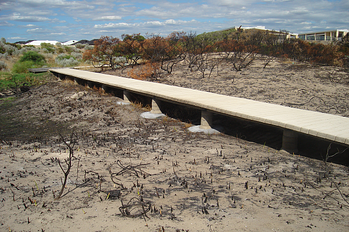
Combustible vs. Noncombustible
One of the first steps designers and owners need to consider is whether or not the boardwalk material is combustible or noncombustible.
Combustible: Various species of timber, wood-plastic composite, and recycled plastic materials are all examples of combustible materials, or materials that may readily ignite and burn. Their performance in a fire can be evaluated by several test methods evaluating specific properties of the material. In an article from Insurance Institute for Business & Home Safety, titled “Fire Ratings for Construction Materials,” Stephen Quarles explains, “With regard to wildfire, two properties are helpful in characterizing the relative combustibility of different materials – flame spread index and heat release rate.”
Noncombustible: Precast concrete is considered a noncombustible material. A material is determined to be noncombustible if does not support a flame or aid combustion when subjected to the Standard Test Method for Behavior of Materials in a Vertical Tube Furnace at 750°C (ASTM Standard E136).
This is the most basic distinction one can make when evaluating materials for use on a public boardwalk, trail system, pedestrian bridge, etc. Once combustibility of the material has been addressed, there are further test methods to provide more specific data on fire performance.
Fire Performance of Combustible Materials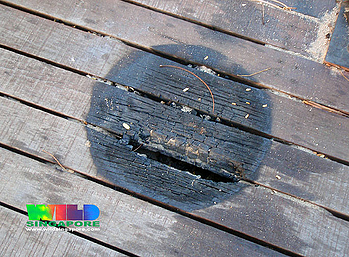
Performance differences range widely between materials that fall within the “combustible” category. As a way to compare these differences, fire resistance ratings are quoted in a number of marketing materials. These ratings aim to put a classification on a material’s relative combustibility, and more specifically, the surface burning characteristics of the material in a fire, as determined by ASTM E84-12c. Websites, blog articles and literature packets from boardwalk material suppliers often reference the resulting classification of the material: Class A, Class B, or Class C fire resistance rating. But what do these ratings really mean?
As mentioned above, two properties are most important to consider in ranking the performance of combustible materials: flame spread index and heat release rate. The testing standard defined by ASTM involves a material being exposed to an open gas flame in a controlled, horizontal tunnel environment. The distance of flame spread, rate of flame spread, and release of heat are all determining factors in measuring the material’s performance. This data translates into a numeric value, which is then classified into one of three categories. Class A fire resistance rating is the best ranking a combustible material can receive. Class B-rated materials will enable a flame to spread faster and further than Class A materials. Most commercial wood species rank to a Class C fire resistance rating, lowest category of the three.
Basic online research into fire resistance ratings can be misleading. The fire resistance ratings we see on supplier websites (determined by ASTM E84-12c) may be leveraged to share their material as fireproof, citing a Class A fire resistance rating. By no means does this mean the product won’t readily ignite or burn. It simply means the material won’t spread a flame or release heat as rapidly as Class B or Class C fire rated materials. It will still ignite, burn and melt – this rating is merely an indicator of how quickly those events will take place.
The vast majority of wood composite or recycled plastic boardwalk materials carry a Class C fire resistance rating. Trex decking, for example, carries a Class C (Class III) fire rating, which means it will burn, spread a flame, and release heat in a similar manner to commercial timber species such as Southern Yellow Pine.
Even contained prescribed burn fires reach temperatures upwards of 1800 degrees Fahrenheit. At that level of intense heat, protecting a public boardwalk investment requires a noncombustible material over a combustible material.
Fire Performance of Noncombustible Materials - Hourly Fire Resistance Rating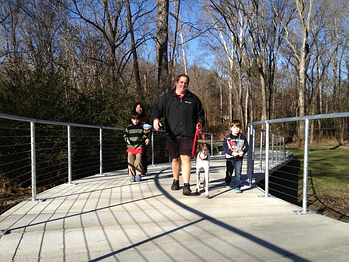
Since precast concrete is considered noncombustible, the Standard Test Methods for Fire Test of Building Construction and Materials (ASTM E119-12a) provides additional information on its performance in a fire. These test methods evaluate building materials based on the amount of time they can “contain a fire, retain their structural integrity, or exhibit both properties during a predetermined test exposure.”
In test results, ratings are typically assigned in half-hour increments, rather than classes as described above for combustible materials. Ratings vary for precast concrete depending on the thickness and density of each component, along with moisture content and aggregate type.
While PermaTrak’s boardwalk components have not been specifically tested for hourly fire resistance ratings, we can point out direct comparisons to other precast concrete construction. The PermaTrak boardwalk system is produced with minimum 4000 psi, normal weight concrete; and PermaTrak standard tread thickness is either 4’’ or 5.5’’. According to Table 720.2.1.1 of IBC-2000, 3.5’’ is the minimum slab thickness of precast concrete walls, produced with most normal weight aggregates, for a 1-hour fire resistance rating. A 1.5-hour rating requires a 4.3’’ thick precast concrete wall slab, and a 2-hour rating is attainable with a 5’’ thick precast concrete wall slab.
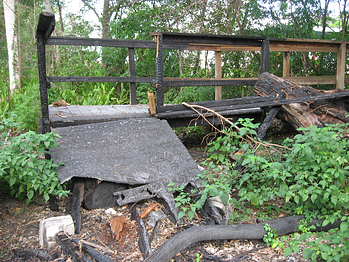
Why are fire resistance ratings a popular topic?
Two weeks ago I met with a program manager in Seminole County, FL and the topic of local prescribed burns came up. In Florida, it is common for counties and other agencies to carry out prescribed burns for several reasons:
-Revitalize the soil
-Lessen the risk of wildfires
-Promote diversity among native plant species
-Reduce undergrowth that builds up in a natural area
This is common across all regions of Florida; Pinellas County is another FL agency using prescribed burns to restore and rejuvenate their environmental land areas.
Public boardwalks, greenway systems, piers or pedestrian bridges are often located in natural land areas – areas where prescribed burns may be necessary.
The use of a noncombustible material such as precast concrete boardwalks gives owners and designers the ability to construct greenways and multi use paths in close proximity to, or even through, prescribed burn areas. This added design flexibility for trail crossing or pedestrian bridge locations expands a designer’s options within a project site. An hourly fire rated material provides otherwise unrealistic hardscape design options, especially through natural land areas where timber or wood composite boardwalks cannot be constructed for fire safety concerns.
Other public agencies have told me they’ve been trying to find a way to combat arson problems with their boardwalks. Teenage vandals can set a boardwalk on fire in a matter of minutes; 1 or 2 hours later a composite boardwalk will look like the photos shown here. These structures are almost always publicly funded; designed and constructed for enjoyment by the public: dog walkers, cyclists, runners, fishermen, etc. Unfortunately, property damages and repairs ultimately become the responsibility of local taxpayers.
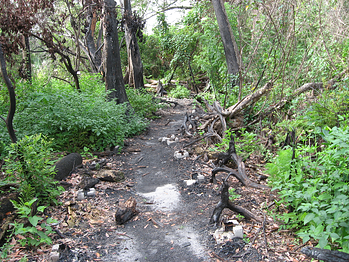
Fire ratings and fire resistance are important considerations for public walkways, as longevity and durability of the structure are emphasized. As we all know, arson is one unknown factor that can be dangerous and expensive for a community to face. The picture to the right shows a wood composite boardwalk hours after several teenage kids snuck out in the middle of the night and set it aflame. This resulted in hundreds of thousands of dollars in property damage. How rewarding would it be to see a high school vandal attempting to light a precast concrete boardwalk on fire? Town of _________: 1, Vandals: 0.
Literature Cited:
ASTM Standard E136, 2012,"Standard Test Method for Behavior of Materials in a Vertical Tube Furnace at 750°C," ASTM International, West Conshohocken, PA, 2012, DOI: 10.1520/E0136-12, www.astm.org.
ASTM Standard E84, 2012c,"Standard Test Method for Surface Burning Characteristics of Building Materials," ASTM International, West Conshohocken, PA, 2012, DOI: 10.1520/E00084-12C, www.astm.org.
ASTM Standard E119, 2012a, "Standard Test Methods for Fire Tests of Building Construction and Materials,” ASTM International, West Conshohocken, PA, 2012, DOI:10.1520/E0119-12A, www.astm.org.
3rd photo by wildsingapore


